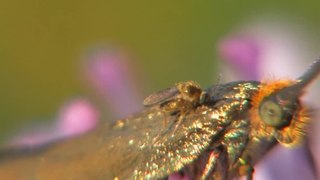
A midge is any small fly, including species in several families of non-mosquito Nematoceran Diptera. Midges are found on practically every land area outside permanently arid deserts and the frigid zones. Some midges, such as many Phlebotominae and Simuliidae, are vectors of various diseases. Many others play useful roles as prey for insectivores, such as various frogs and swallows. Others are important as detritivores, and form part of various nutrient cycles. The habits of midges vary greatly from species to species, though within any particular family, midges commonly have similar ecological roles.

Ceratopogonidae is a family of flies commonly known as no-see-ums, or biting midges, generally 1–3 millimetres in length. The family includes more than 5,000 species, distributed worldwide, apart from the Antarctic and the Arctic.

Forcipomyia is a genus of biting midges in the subfamily Forcipomyiinae. Species of the subgenus Lasiohelea suck vertebrate blood. Some species are ectoparasites on larger insects. Other species in the genus are important pollinators of the cacao tree. There are at least 1,000 described species in Forcipomyia.

Atrichopogon is a genus of biting midges, small flies in the family Ceratopogonidae.
Probezzia xanthogaster is a species of biting midges in the family Ceratopogonidae.

Bezzia is a genus of biting midges in the family Ceratopogonidae. There are more than 310 described species in Bezzia.

Palpomyiini is a tribe of biting midges in the family Ceratopogonidae. There are about 5 genera and more than 610 described species in Palpomyiini.
Forcipomyia fuliginosa is a species of biting midges.
Phaenobezzia opaca is a species of biting midge in the family Ceratopogonidae.
Mallochohelea atripes is a species of biting midges in the family Ceratopogonidae.
Clinohelea bimaculata is a species of biting midges in the family Ceratopogonidae from North America.

Heteromyiini is a tribe of biting midges in the family Ceratopogonidae. There are about 5 genera and 16 described species in Heteromyiini.

Stilobezzia is a genus of predaceous midges in the family Ceratopogonidae. There are more than 330 described species in Stilobezzia.
Nilobezzia mallochi is a species of biting midge in the family Ceratopogonidae.
Alluaudomyia is a genus of predaceous midges in the family Ceratopogonidae. There are more than 180 described species in Alluaudomyia.
Forcipomyia pluvialis is a species of biting midges.
Allohelea johannseni is a species of predaceous midge in the family Ceratopogonidae.
Atrichopogon peregrinus is a species of biting midges.
Culicoides villosipennis is a species of biting midge in the family Ceratopogonidae.
Jenkinshelea albaria is a species of biting midges in the family Ceratopogonidae.






